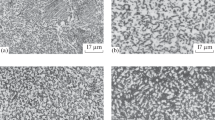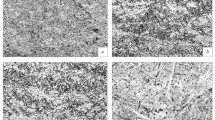Summary
-
1.
Hydrogen embrittlement of α+β titanium alloys is much more pronounced after quenching than after standard annealing.
The decrease in the ductility of the α+β titanium alloys is particularly sharp during aging at room temperature, but not immediately after quenching.
-
3.
Quenched α+β titanium alloys must be subjected to mechanical tests after no less than 1 month at room temperature.
-
4.
The maximum acceptable amount of hydrogen in quenched α+β titanium alloys is less than in the annealed alloys: 0.005% for the VT3-1 alloy and 0.015–0.02% for the VT6 alloy.
-
5.
The instability of the quenched VT3-1 and VTS alloys' saturated hydrogen is due to the decomposition of the solid solution supersaturated with hydrogen.
Similar content being viewed by others
Additional information
Translated from Metallovedenie i Termicheskaya Obrabotka Metallov, No. 5, pp. 9–15, May, 1965
Rights and permissions
About this article
Cite this article
Kolachev, B.A., Livanov, V.A., Bukhanova, A.A. et al. Effect of hydrogen on the mechanical properties of quenched titanium alloys. Met Sci Heat Treat 7, 286–290 (1965). https://doi.org/10.1007/BF00649015
Issue Date:
DOI: https://doi.org/10.1007/BF00649015




